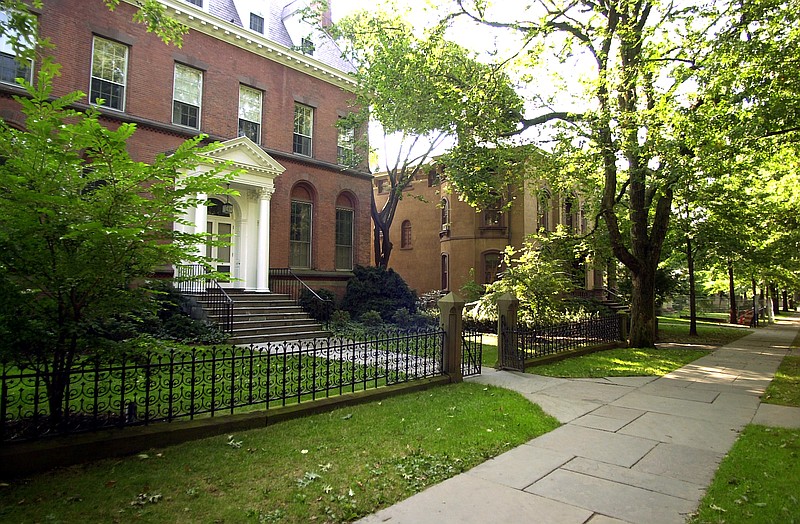Well, it sounded brave
A group of Yale University doctoral students, who have their tuition paid, receive additional $30,000 stipends and get free health care, declared last week they would strike for better union benefits. And they would do it in front of the home of Yale President Peter Salovey.
"Yale wants to make us wait and wait and wait until we give up and go away," the eight members of the graduate student union Local 33 - yes, a graduate student union! - said. "We have committed ourselves to waiting without eating."
The move was praised by the co-founder of the National Farm Workers Association and the vice chairwoman of the Democratic National Committee.
Meanwhile, the university administration cautioned the students not to put their health at risk, and it turns out they're really not.
The hunger strike, according to a pamphlet posted on Twitter by a former Yale student, is "symbolic." In actuality, the striking students can leave and go get food when they feel they need it.
The former student nevertheless called the "strike" "inspirational," but others on social media had a field day.
"Yeah," Blake Hounshell said, "that's not really how hunger strikes work."
"Reminds me of when the progressive group at my undergrad held a 'sleep out' for the homelessness night - but moved inside when it rained," said Philip Klein.
"I'm a vegetarian," mocked Ian Tuttle. "But I also eat chicken, beef, and pork."
Fire in a crowded theater?
A group of leftist Harvard University students recently sent out a fraudulent letter using the school's official seal to convince other students their dorm mates had been "detained indefinitely" by Harvard's Special Investigations Unit.
"A resident of this dorm has been detained indefinitely due to suspicious actions, suspected violent inclinations, or suspicion of being a deportable illegal alien," the front of the leaflet stated. "This is a matter of special investigation under the strict jurisdiction of the Harvard Corp. and ensures the safety of all students. You will not be able to contact the suspect at any time during their indefinite detention."
The letter goes on to condemn U.S. policy toward immigrants, Muslim Americans, Israel's supposed crimes against Palestinians in prison, the outsized number of arrests of blacks and the killing of Hispanics by police officers.
The missive actually was written by the Harvard Palestinian Solidarity Committee, Harvard Consilio Latino, Harvard Islamic Society and Harvard Black Student Association. Oh, yes, on the back it reveals "this is not a real notice," but pleads for hope that "the unsettling nature of this notice allows Harvard community members to reflect on the reality of people who face these kinds of unwarranted disruptions of life."
The school has not responded to the misuse of its logo, and at least one student found that unsettling.
"I think it's interesting how this sort of thing is constantly propagated around campus, but the moment someone says something in favor of Trump, stricter immigration laws, or fiscal responsibility, you get bashed for it," the student told Campus Reform. "I'm all in favor of free speech but the double standard is puzzling."
Your tax dollars at work
A recent audit from the Government Accountability Office (GAO) revealed the federal government spent $13.5 million between 2011 and 2015 on cars and SUVs it had no idea whether it needed.
It further hit taxpayers for $2.5 million for fluffy options such as heated seats, remote keyless starters, leather seats and video entertainment systems.
Among the findings: The Customs and Border Protection agency could not establish whether 81 percent of its vehicles were used in 2015; more than 1,800 of the agency's other vehicles were driven less than 12,000 miles during the same year, the minimum mileage required by the parent Department of Homeland Security to justify a vehicle purchase; between the border protection agency and the Natural Resources Conservation Service (within the Department of Agriculture), $13.5 million was tallied for depreciation and maintenance for vehicles neither agency could say were used.
"Each federal agency is responsible for determining utilization criteria and assessing vehicle utilization," the GAO said.
Of the luxury items, which included installed sound systems on six vehicles worth more than $3,000 each and heated or leather seats in many others costing $49,476, the accounting office said, "In analyzing these options, we were not able to determine if six of these types of options were related to safety, efficiency, economy, suitability, or administrative functions."
100 days' worth
Traditional media has made much of President Donald Trump's first 100 days in office - some from his boasts of what he'd do - but he's no Barack Obama.
In Obama's first 100 days in office, he imposed $4 billion in regulatory costs to the American people, while Trump tallied $28 million, less than 1 percent of what his predecessor did. Indeed, the president also made changes resulting in a $3.6 billion drop in regulatory burdens.
The American Action Forum, extending the 100 days over four years, calculated that Trump could reduce regulatory costs by $52.5 billion. That would be a nearly $550 billion difference from the $501 billion increase in regulatory costs in Obama's first term, between 2009 and 2012.
